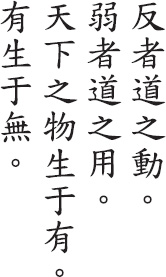40
 |
The Tao moves the other way the Tao works through weakness the things of this world come from something something comes from nothing |
LIU CH’EN-WENG says, “Once things reach their limit, they have to go back the other way.”
WEI YUAN says, “The Tao moves contrary to how most people look at things.”
CH’AO CHIH-CHIEN says, “To go back the other way means to return to the root. Those who cultivate the Tao ignore the twigs and seek the root. This is the movement of the Tao: to return to where the mind is still and empty and actions soft and weak. The Tao, however, does not actually come or go. It never leaves. Hence, it cannot return. Only what has form returns. ‘Something’ refers to breath. Before things have form they have breath. Heaven and Earth and the ten thousand things are born from breath. Hence, they all come from something. ‘Nothing’ refers to the Tao. Breath comes from the Tao. Hence, it comes from nothing. This is the movement of the Tao.”
WANG AN-SHIH says, “The reason the Tao works through weakness is because it is empty. We see it in Heaven blowing through the great void. We see it in Earth sinking into the deepest depths.”
TE-CH’ING says, “People only know the work of working. They don’t know that the work of not working is the greatest work of all. They only know that everything comes from something. They don’t know that something comes from nothing. If they knew that something came from nothing, they would no longer enslave themselves to things. They would turn, instead, to the Tao and concentrate on their spirit.”
HO-SHANG KUNG says, “The ten thousand things all come from Heaven and Earth. Heaven and Earth have position and form. Hence, we say things come from something. The light and spirit of Heaven and Earth, the flight of insects, the movement of worms, these all come from the Tao. The Tao has no form. Hence, we say things come from nothing. This means the root comes before the flower, weakness comes before strength, humility comes before conceit.”
LI JUNG says, “‘Something’ refers to Heaven and Earth. Through the protection of Heaven and the support of Earth, all things come into being. ‘Nothing’ refers to the Tao. The Tao is formless and empty, and yet it gives birth to Heaven and Earth. Thus, it is said, ‘Emptiness is the root of Heaven and Earth. Nothingness is the source of all things.’ Those who lose the Tao don’t realize where things come from.”
SU CH’E says, “As for ‘the things of this world,’ I have heard of a mother giving birth to a child. But I have never heard of a child giving birth to its mother.”
WANG PI says, “Everything in the world comes from being, and being comes from nonbeing. If you would reach perfect being, you have to go back to nonbeing.”
HUANG YUAN-CHI says, “Those who cultivate the Way should act with humility and harmony. The slightest carelessness, any action at all, can destroy everything. Those who cultivate Virtue look to themselves for the truth, not to the words of others. For those who understand that what moves them is also the source of their lives, the pill of immortality is not somewhere outside.”
The moon can’t keep up with the sun, but as it gets farther and farther behind, the darkness of nothing gives rise to the light of something. In line three, some editions add wan (ten thousand) to wu (things). The Mawangtui texts reverse the order of verses 40 and 41. Also, some commentators read 40 as a continuation of 39, while others combine it with 41. Wentzu: 1 provides a slightly different version of the first two lines: “The Tao works through weakness / the Tao keeps moving the other way.” The Kuotien texts do not have the word yu (something) in line four. Scholars disagree as to whether this was intentional or simply a copyist error.